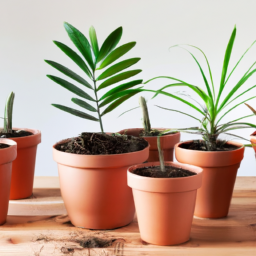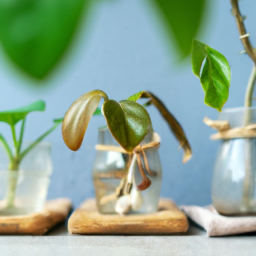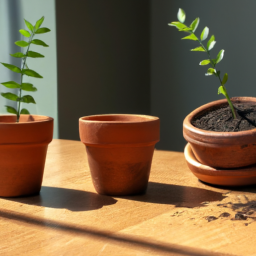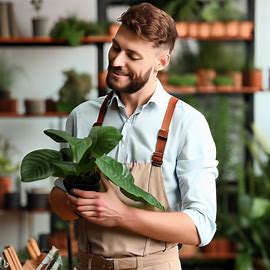
Have you noticed the rise of plant parenting lately? It seems like everywhere you look, people are embracing the trend of bringing plants into their homes and treating them like beloved family members. From small succulents perched on windowsills to sprawling monstera plants taking over living rooms, plant parenting is undoubtedly a growing trend. In this blog post, we will explore the reasons behind this green movement, the benefits of becoming a plant parent, and how to successfully care for your leafy companions. So, grab your watering can and join us as we delve into the fascinating world of plant parenting!
Benefits of Plant Parenting: How Growing Plants Can Improve Your Well-being
Plant parenting, also known as the trend of nurturing and caring for indoor plants, has been on the rise in recent years. It’s not just a passing fad; it’s a growing movement that has captured the hearts of many. People are realizing the numerous benefits of bringing plants into their lives and homes. In this article, we will explore how plant parenting can improve your well-being and why it has become such a popular trend.
1. Boosts Mental Health
Gardening and tending to plants have long been recognized as therapeutic activities. The act of nurturing a living thing can have a profound impact on our mental well-being. The process of caring for plants requires patience, attention, and responsibility, which can help reduce stress and anxiety. When we see our plants thriving and growing, it gives us a sense of accomplishment and boosts our self-esteem. The act of gardening also provides a sense of purpose and can distract us from negative thoughts or worries.
Moreover, plants have the ability to improve our mood and overall mental health. Studies have shown that being around plants and nature can reduce symptoms of depression and improve overall life satisfaction. The presence of greenery indoors can create a calming and peaceful atmosphere, which can help alleviate stress and promote relaxation. Plant parenting allows us to create a nurturing environment that supports our mental well-being.
In addition, taking care of plants can also improve our focus and concentration. It requires us to be present and mindful of their needs, which can help train our minds to stay focused on the task at hand. This can be particularly beneficial for those who struggle with attention disorders or have a hectic lifestyle.
2. Enhances Indoor Air Quality
Indoor air pollution is a growing concern in today’s world. We spend a significant amount of time indoors, and the air we breathe can have a direct impact on our health. Fortunately, plants can act as natural air purifiers, filtering out harmful toxins and improving indoor air quality.
Plants absorb carbon dioxide and release oxygen through the process of photosynthesis. However, they also have the ability to remove volatile organic compounds (VOCs) from the air. VOCs are chemicals commonly found in household products, furniture, and building materials, and they can have detrimental effects on our health. By introducing plants into our living spaces, we can reduce the levels of VOCs and create a healthier environment for ourselves and our families.
Furthermore, plants can increase humidity levels indoors, which can be beneficial, especially during dry seasons or in areas with low humidity. Dry air can cause respiratory problems, dry skin, and other health issues. Having plants in our homes can help maintain optimal humidity levels and improve our overall well-being.
3. Promotes Physical Health
Plant parenting not only benefits our mental well-being but also promotes physical health. Taking care of plants involves physical activity, such as watering, pruning, and repotting. These activities can be a form of exercise and help improve our strength, flexibility, and coordination.
Gardening has also been associated with reduced risk of chronic diseases, including heart disease, obesity, and diabetes. It can be a moderate-intensity exercise that helps burn calories and maintain a healthy weight. Additionally, spending time outdoors while tending to plants exposes us to natural sunlight, which is a natural source of vitamin D. Vitamin D is essential for bone health, immune function, and overall well-being.
Moreover, having plants in our living spaces can also improve our sleep quality. Certain plants, such as lavender and jasmine, have calming properties and can promote relaxation. Better sleep translates to better physical health and overall productivity.
In conclusion, plant parenting is a growing trend that offers numerous benefits for our well-being. From boosting mental health to enhancing indoor air quality and promoting physical health, the act of caring for plants can have a positive impact on our lives. So, why not join the plant parenting movement and experience the joys and benefits of nurturing nature in your own home?

Tips for Successful Plant Parenting: Essential Care and Maintenance for Indoor Plants
Welcome to the world of plant parenting! As more and more people embrace the joy and benefits of indoor plants,
it’s essential to understand the necessary care and maintenance to ensure your leafy friends thrive. In this
guide, we will provide you with expert tips and insights to help you become a successful plant parent.
Choose the Right Plants for Your Space
The first step in plant parenting is selecting the right plants for your indoor space. Consider factors such as
lighting conditions, temperature, and humidity levels. Some plants thrive in bright, direct sunlight, while
others prefer indirect light or shade. Research the specific needs of each plant before bringing them home.
Additionally, take into account the size of your space and the growth habit of the plants you choose. Some
varieties can grow quite large, while others remain compact. Make sure to choose plants that fit well within
your available space.
Finally, consider your lifestyle and schedule. Some plants require more attention and care than others. If you
have a busy lifestyle, opt for low-maintenance plants that can tolerate occasional neglect.
Pro tip: Some popular indoor plants that are known for their easy care include pothos, snake
plants, ZZ plants, and succulents. These plants are great choices for beginners or those with a busy schedule.
Provide Adequate Lighting
Light is one of the most crucial factors for indoor plant health. Most indoor plants require bright, indirect
light to thrive. Place your plants near windows with filtered sunlight or use artificial grow lights if natural
light is limited.
It’s important to understand the lighting needs of your specific plants. Some plants, like succulents and
cacti, prefer direct sunlight, while others, such as ferns and peace lilies, thrive in lower light conditions.
Observe your plants and adjust their placement accordingly to ensure they receive the right amount of light.
Pro tip: Rotate your plants every few weeks to ensure even growth. Plants tend to lean towards
the light source, so rotating them will help them grow straight and evenly.
Watering and Humidity
Proper watering is crucial for the health of your indoor plants. The key is to find the right balance – avoid
overwatering or underwatering. Most plants prefer to dry out slightly between waterings, so make sure the top
inch of soil is dry before watering again. Use your finger to test the moisture level.
Remember that different plants have different water requirements. Succulents, for example, need infrequent
watering, while tropical plants may require more frequent watering. Research the specific needs of your plants
to avoid water-related issues.
In addition to watering, consider the humidity levels in your home. Some plants, like ferns and orchids, thrive
in higher humidity environments. You can increase humidity by placing a tray of water near your plants or using
a humidifier.
Pro tip: Avoid using cold water directly from the tap. Allow the water to sit overnight to
reach room temperature, as cold water can shock the roots of your plants.
Fertilizing and Pruning
Fertilizing your indoor plants is essential to provide them with the necessary nutrients for healthy growth.
Choose a balanced, water-soluble fertilizer and follow the instructions on the packaging. It’s generally
recommended to fertilize once a month during the growing season (spring and summer) and reduce or stop
fertilizing during the dormant period (fall and winter).
Pruning is another important aspect of plant care. Regularly remove dead or yellowing leaves to promote new
growth. Trim back leggy stems to encourage bushier growth. Pruning also helps maintain the overall shape and
appearance of your plants.
Pro tip: Avoid over-fertilizing, as it can lead to burn or damage to the roots. Always dilute
the fertilizer according to the instructions and err on the side of caution.
Pest Control and Maintenance
Like any living organism, indoor plants can be susceptible to pests. Common pests include aphids, spider mites,
and mealybugs. Regularly inspect your plants for signs of infestation, such as sticky residue, webbing, or
discolored leaves. If you notice any pests, take immediate action to prevent them from spreading.
There are various methods for pest control, including natural remedies like neem oil or insecticidal soaps.
Research the specific pest and plant to find the most effective treatment. Additionally, maintaining good
hygiene by cleaning leaves and regularly dusting your plants can help prevent pest infestations.
Pro tip: Quarantine new plants before introducing them to your existing plant collection. This
will help prevent the spread of pests to your healthy plants.
Conclusion
Plant parenting is a rewarding and fulfilling journey. By following these essential care and maintenance tips,
you’ll be well on your way to becoming a successful plant parent. Remember to choose the right plants for your
space, provide adequate lighting, water and fertilize appropriately, and keep an eye out for pests. With time,
patience, and a little bit of love, your indoor plants will thrive and bring beauty to your home or office.

Sustainable Plant Parenting: Promoting Eco-Friendly Practices in Urban Gardening
Introduction
Urban gardening has experienced a remarkable surge in popularity over the past few years, with more and more people embracing the joys of plant parenting. As this trend continues to grow, it is essential to highlight the importance of sustainable practices in urban gardening. By adopting eco-friendly techniques, plant parents can not only create beautiful green spaces but also contribute to a healthier environment. In this article, we will explore the concept of sustainable plant parenting and provide you with a step-by-step guide to incorporating eco-friendly practices into your urban garden.
The Benefits of Sustainable Plant Parenting
Sustainable plant parenting goes beyond simply growing plants; it involves creating a harmonious ecosystem that supports both the plants and the environment they thrive in. By adopting eco-friendly practices, you can reap numerous benefits, including:
1. Environmental Preservation: Sustainable gardening helps reduce the carbon footprint by promoting healthier air quality, conserving water, and minimizing the use of harmful chemicals. By choosing organic fertilizers and pest control methods, you contribute to the overall well-being of the ecosystem.
2. Conservation of Resources: Urban gardening often faces resource constraints, such as limited space and water availability. Sustainable plant parenting focuses on maximizing the use of available resources, utilizing vertical gardening techniques, rainwater harvesting, and composting to minimize waste and optimize plant growth.
3. Biodiversity Enhancement: By incorporating native plants and creating diverse habitats, sustainable plant parenting supports local wildlife, including birds, butterflies, and bees. This, in turn, helps in pollination and the overall health of the ecosystem.
Step-by-Step Guide to Sustainable Plant Parenting
1. Choose Native Plants: Opt for native plants that are adapted to the local climate and require less maintenance. Native plants have evolved to thrive in the specific conditions of your region, reducing the need for excessive watering, fertilizers, and pesticides.
2. Soil Health: Prioritize soil health by enriching it with organic matter like compost or well-rotted manure. This improves soil structure, promotes nutrient retention, and reduces the need for synthetic fertilizers. Regularly test the pH levels and adjust accordingly to ensure optimal plant growth.
3. Water Conservation: Implement water-saving techniques such as drip irrigation or soaker hoses to deliver water directly to the plant roots, minimizing evaporation. Collect rainwater in barrels and use it for watering your plants. Mulching is another effective method to retain soil moisture and suppress weed growth.
4. Integrated Pest Management (IPM): Embrace natural pest control methods to minimize the use of harmful chemicals. Encourage beneficial insects like ladybugs and lacewings, which feed on pests, and use companion planting techniques to deter pests naturally.
5. Composting: Start a compost pile or bin to recycle kitchen scraps, yard waste, and plant trimmings. Compost enriches the soil with nutrients, reduces the need for synthetic fertilizers, and diverts organic waste from landfills.
6. Vertical Gardening: Make the most of limited space by utilizing vertical gardening techniques. Install trellises, hanging baskets, or vertical planters to grow plants upwards, optimizing space and creating a visually appealing garden.
7. Wildlife-Friendly Features: Incorporate bird feeders, bird baths, and native flowering plants to attract birds, butterflies, and bees. These pollinators play a crucial role in plant reproduction and contribute to a flourishing urban ecosystem.
8. Regular Maintenance: Regularly inspect your plants for signs of disease or pest infestation. Prune and trim plants to promote healthy growth and improve air circulation. Remove weeds manually to avoid the use of herbicides.
Conclusion
As the trend of plant parenting continues to rise, it is essential to embrace sustainable practices in urban gardening. By following this step-by-step guide, you can create an eco-friendly garden that not only enhances the beauty of your surroundings but also contributes to the preservation of our planet. Sustainable plant parenting is not only a growing trend but also a responsible way to connect with nature and promote a greener future. So, grab your gardening tools, get your hands dirty, and embark on a journey of sustainable plant parenting today!
Key Takeaways of this article
Plant parenting, the act of nurturing and caring for houseplants, has become an incredibly popular trend in recent years. Whether you’re a seasoned gardener or a complete novice, the idea of bringing nature indoors and tending to a variety of beautiful plants has captivated the hearts of many. It’s no wonder that plant parenting is on the rise – not only does it add a touch of greenery to our living spaces, but it also offers a plethora of benefits for our mental and physical well-being.
One of the reasons behind the surge in plant parenting is the desire to create a calming and peaceful environment at home. With the hustle and bustle of modern life, we often find ourselves longing for a sanctuary where we can unwind and recharge. Houseplants provide just that. They purify the air, increase humidity, and create a soothing atmosphere that promotes relaxation and reduces stress. Additionally, studies have shown that being surrounded by plants can improve concentration, boost productivity, and even enhance our mood. It’s no wonder that more and more people are turning to plant parenting as a way to enhance their overall well-being.
FAQ Compilation:
Q1: What is plant parenting?
A1: Plant parenting refers to the growing trend of individuals taking care of and nurturing indoor plants as if they were their own children. It involves the responsibility of providing the necessary care, attention, and love to ensure the plants thrive and flourish.
Q2: Why has plant parenting become so popular?
A2: Plant parenting has gained popularity for several reasons. Firstly, it allows people to bring nature indoors and create a calming and aesthetically pleasing environment. Additionally, taking care of plants can be a fulfilling hobby that provides a sense of purpose and accomplishment. Moreover, plants are known to have numerous health benefits, such as improving air quality and reducing stress levels.
Q3: What are some common challenges faced by plant parents?
A3: Plant parenting can come with its fair share of challenges. One common difficulty is understanding the specific needs of each plant, such as the amount of sunlight, water, and humidity they require. Overwatering or neglecting plants can lead to their decline. Pests and diseases can also pose a challenge, requiring plant parents to learn about prevention and treatment methods. Finally, finding the right balance between caring for plants and managing other responsibilities can be a juggling act.
Q4: How can someone become a successful plant parent?
A4: To become a successful plant parent, it’s important to start by researching and understanding the specific needs of the plants you intend to care for. This includes learning about their light requirements, watering schedules, and any additional care they may need. Providing the right environment, such as suitable pots, soil, and humidity levels, is crucial. Regularly monitoring the plants, observing their growth, and making adjustments as needed is also essential. Lastly, patience and a willingness to learn from any setbacks or failures are key traits of successful plant parents.
Q5: What are some popular plants for beginners in plant parenting?
A5: For beginners in plant parenting, there are several low-maintenance plants that are great for getting started. Some popular options include pothos, snake plants, spider plants, and peace lilies. These plants are known for their ability to tolerate a variety of light conditions and are generally forgiving when it comes to watering mistakes. They are also relatively resistant to pests and diseases, making them ideal choices for those new to plant parenting.

Alex Turner is a sustainable gardening advocate and the founder of an acclaimed indoor gardening blog. With a focus on eco-friendly practices and urban sustainability, Alex combines his background in environmental studies with his love for plants to educate readers on mindful indoor gardening. His work highlights the importance of nurturing both plants and the planet.


